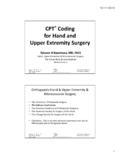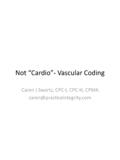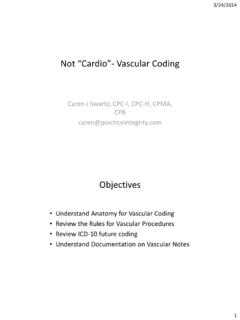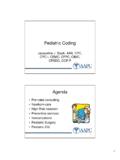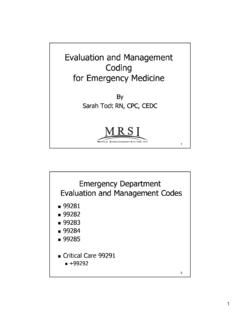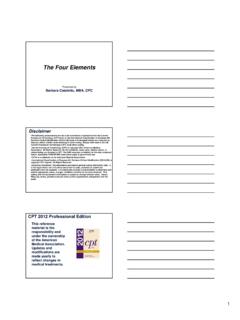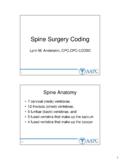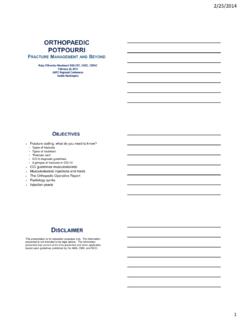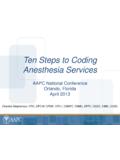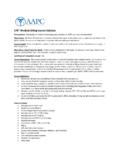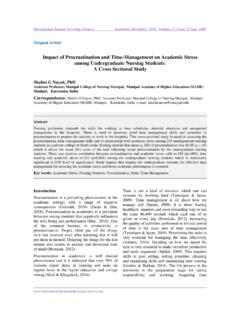Transcription of Clinical Documentation Improvement - AAPC
1 Clinical Documentation ImprovementBy: Quita Edwards, CPC, CPMA, CPC-I, COSC ii AAPC 1-800-626-CODE (2633) CPT copyright 2011 American Medical Association. All rights This course was current at the time it was published. This course was prepared as a tool to assist the participant in educat-ing providers and is not intended to grant rights or impose obligations. Although every reasonable effort has been made to assure the accuracy of the information within these pages, the ultimate responsibility for the correct submission of claims and response to any remittance advice lies with the provider of services. AAPC employees, agents, and staff make no representation, warranty, or guarantee that this compilation of information is error-free and will bear no responsibility or liability for the results or consequences of the use of this course.
2 This guide is a general summary that explains commonly accepted aspects of selecting Evaluation and Management (E/M) codes, but it is not a legal document. View points are discussed from the standpoint of the 1995 and 1997 Centers for Medicare and Medicaid Services (CMS) Evaluation and Management Documentation Guidelines with medical necessity and the nature of the presenting problem as the primary criterion of code selection (Medicare Claims Processing Manual Chapter 12 Physicians/Nonphysician Practitioners, Selection of Level of Evaluation and Management Service, A. Use of CPT Codes.) For the purpose of objective consistency, specific logics are primarily based on the same used by the E/M Documentation Auditors Worksheet, Marsh-field Clinic, available through the Medical Group Management Association (MGMA).
3 Specific payers, including Medicare Carriers, may use different and sometimes varied audit tools logics to gain objective consistency around the 95 and 97 Documentation Guidelines. Official provisions are contained in the relevant laws, regulations, rulings and contractual agreements of Current Procedural Terminology (CPT ) is copyright 2011 American Medical Association. All Rights Reserved. CPT is a registered trademark of the American Medical Association (AMA). It is recommended that the participant of this course will be familiar with: z1995 Documentation Guidelines for Evaluation and Management Services z1997 Documentation Guidelines for Evaluation and Management ServicesThese may be downloaded from the CMS website at: Regarding Clinical Examples Used in this BookAAPC believes it is important in training and testing to reflect as accurate a coding setting as possible to students and examinees.
4 All examples and case studies used in our study guides and exams are actual, redacted office visit and proce-dure notes donated by AAPC preserve the real world quality of these notes for educational purposes, we have not rewritten or edited the notes to the stringent grammatical or stylistic standards found in the text of our products. Some minor changes have been made for clarity or to correct spelling errors originally in the notes, but essentially they are as one would find them in a coding setting. 2012 AAPC2480 South 3850 West, Suite B, Salt Lake City, Utah 84120800-626-CODE (2633), Fax 801-236-2258, rights , CPC-H , CPC-P , CIRCC , CPCOTM, and CPMATM are trademarks of Documentation Improvement iiiContentsContentsIntroduction.
5 1 The Professional Side of Clinical Documentation ..1 Agenda ..2 Clinical Documentation 1: ..2 The Role of the Clinical Documentation If it isn t documented, it s not done..3 Chapter 2: ..3 The Quality of Documentation ..3 The Least Expected ..4 The Patient Centered Medical Accuracy and Timing of Documentation ..6 Diagnostic Data ..7 Financial Impact ..7 Legal Protection ..8 Chapter 3: ..8 The Electronic Medical in the Use of Electronic Medical Records ..8 Authentication of Author ..9 Integrity of Patient Assisted Coding ..10 Signature Requirements ..10 Patient Confidentiality ..10 Chapter 4: ..11 Mastering the Documentation Seven Basic Components of a Voluntary Compliance Program.
6 12 Medical XVIII of the Social Security Act, section 1862(a) (1) (A)..13 Medical Necessity is the overarching criterion for code selection..13 Authoritative Resources ..14 Educating the AAPC 1-800-626-CODE (2633) CPT copyright 2011 American Medical Association. All rights 5: ..17 The Impact of ICD-10 on Clinical Documentation ..17 ICD-9 versus ICD-10 ..17 Combination Categories at Risk for Insufficient Documentation ICD-10-CM ..18 Diabetes Mellitus (DM) ..18 Injuries ..19 ICD-10-CM Chapter 19: Injury, poisoning, and certain other consequences of external cause (S00-T88) ..19 ICD-10-CM Chapter 13 (M00-M99) ..21 Pregnancy ..21 Neoplasm.
7 21 Terminology ..21 Potential categories at risk for insufficient Documentation ICD-10 ..22 Examples: ..22 Chapter 6: ..23 Coding and Abstracting ..23 Coding and Abstracting Go Hand In Hand..24 Coding and Billing Risk Areas for Physician Practices..27 Chapter 7: ..27 The Implementation of a CDI Plan .. 27 Conducting Appropriate Training and Education ..28 Enforcement of A Signature Requirements ..29 Appendix B Exercises ..29 Exercise 1 E-Medical Record Documentation Review ..37 Exercise 2 Operative 3 E-Medical Record Documentation 3 Improvement ..50 Exercise 4 Evaluation and Management ..55 Exercise 5 Operative Reports ..59 Appendix C Answers to Exercises.
8 63 PowerPoint Presentation ..87 Clinical Documentation ImprovementClinical Documentation Improvement 1 IntroductionClinical Documentation Improvement is a prevailing topic in the health care industry. Clinical Documentation is the catalyst for coding, billing, and auditing, and is the con-duit for (and provides evidence of) the quality and conti-nuity of patient care. This program is designed to provide a true representation of the impact Clinical Documentation has in the health care industry, and to emphasize the criti-cal characteristics of and reimbursement professionals are at the center of Clinical Documentation Improvement . This aspect of health care services not only includes coding and billing, but reaches beyond to include the Documentation of qual-ity of care.
9 Clinical Documentation Improvement is a proactive mea-sure. There must be consistency and attention to detail to improve Clinical Documentation . The focus of docu-mentation Improvement should not be solely directed on reimbursement. As reimbursement models shift from fee for service to quality of care and patient outcomes, there is a need to efficiently communicate the quality of care pro-vided and patient outcomes associated with that care. Much like the designation of a HIPAA compliance offi-cer, every office/facility should have a designated Clinical Documentation Specialist (CDS). Job titles may vary for this position. For example, other common job titles include Quality Assurance Auditors, Quality Improvement Audi-tors, and Clinical Record Auditors.
10 Throughout this pre-sentation, it will be referred to as CDS. If the practice is relatively large, a team of individuals, working together for the purpose of Clinical Documenta-tion Improvement , (CDI), can manage compliance. The CDS must be knowledgeable in the specialty, and able to understand the requirements for coding and reporting within that specialty. The CDS must also be proficient in the specialty s terminology, anatomy, and CDS will develop and monitor policies and procedures that affect the Documentation process. Practices or facilities may have different needs because of different specialties and services provided. CDI should begin at the front end of all services and care.
